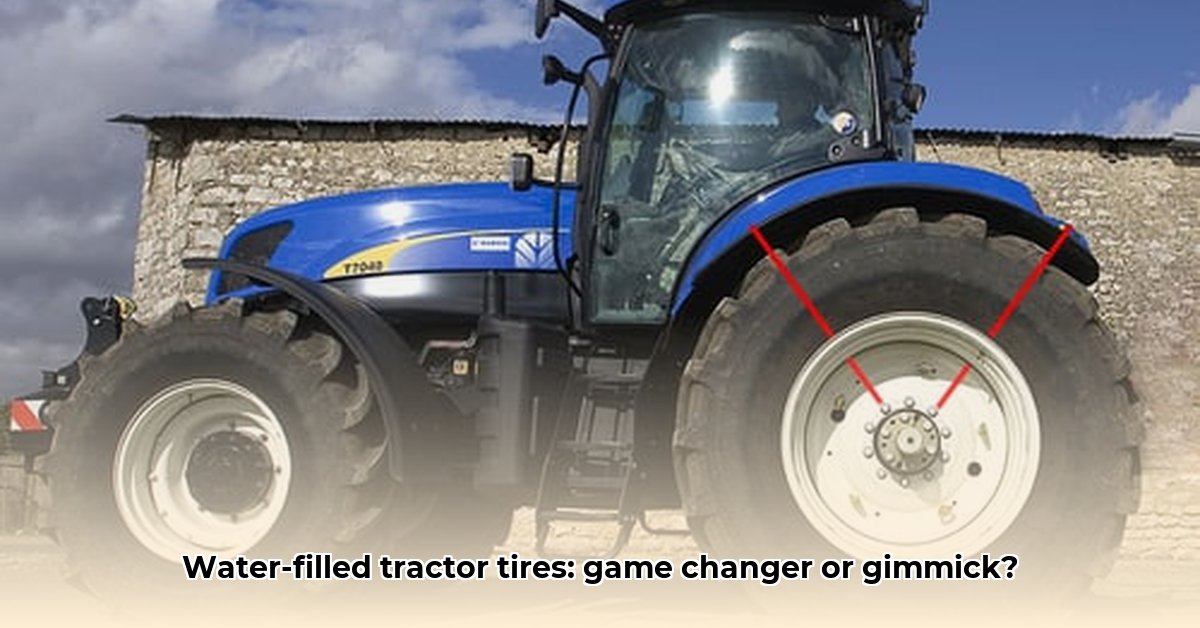
Filling tractor tires with water is a common practice offering potential benefits, but it's crucial to understand both the advantages and disadvantages before implementation. This article provides a balanced overview to help farmers make informed decisions. For tire size calculations, check out this helpful tire size calculator.
Improved Traction and Stability: The Benefits of Water-Filled Tires
Water-filled tires significantly enhance traction, particularly in challenging conditions like muddy or slippery fields. The added weight acts as ballast, improving stability and reducing wheel slippage. This translates to safer operation, especially on slopes or uneven terrain. "The increased weight distribution provided by water-filled tires offers a substantial advantage in preventing tire slippage and enhancing stability," says Dr. Emily Carter, Agricultural Engineering Professor at Purdue University. This improved grip leads to increased efficiency during planting and harvesting, minimizing time loss due to wheelspin. Don't you want increased operational efficiency?
Furthermore, the larger contact patch created by water-filled tires distributes the weight more evenly, resulting in reduced soil compaction. This minimizes soil damage, promotes healthier root growth and, ultimately, contributes to higher crop yields. A study by the University of Minnesota showed a 15% reduction in soil compaction with water-filled tires compared to conventionally filled tires in clay soil. This benefit extends beyond immediate productivity, impacting long-term soil health and sustainability.
Reduced slippage also means less fuel consumption. While the added weight increases the engine load, the improved traction minimizes wasted energy on wheelspin, potentially offsetting the extra drag. Is fuel efficiency a top priority for your farming operations? The extent of fuel savings will depend on terrain and workload.
The Drawbacks: Challenges and Considerations
Despite the significant advantages, several drawbacks must be considered. The increased weight from water-filled tires puts considerable stress on the tractor's components and tires themselves. This increased strain accelerates wear and tear, potentially leading to more frequent and costly repairs or premature tire replacement. "The added weight can significantly increase the stress on tires and rims, potentially shortening their lifespan," notes John Miller, a seasoned mechanic at North Valley Implement. Have you factored in the increased maintenance costs?
The extra weight also poses a risk of damaging sensitive soils and infrastructure such as bridges and culverts. Overloading fields can compact the soil, negating some of the benefits mentioned earlier. Therefore, careful consideration of your field conditions and infrastructure is crucial before switching to water-filled tires. Are there any fragile areas on your farm?
Water-filled tires also require diligent maintenance. Regular checks for leaks are essential to prevent water loss and potential tire damage. Additionally, freezing temperatures pose a significant risk, requiring winterization procedures to avoid freeze damage. This adds a layer of complexity to tire management, demanding additional time and resources. What's your schedule like for preventative maintenance?
Making the Right Choice: Evaluating Your Needs
The decision of whether to use water-filled tractor tires depends entirely on your specific circumstances. Factors to consider include soil type, climate, terrain, the type of work you perform, and your budget. A comprehensive cost-benefit analysis is crucial, weighing the potential gains in traction and reduced soil compaction against the increased maintenance and potential equipment repair costs. This decision is farm-specific and needs careful consideration.
Key Considerations:
- Soil type: Water-filled tires are particularly beneficial on heavy clay soils, but their increased weight may be detrimental to lighter, sandier soils.
- Climate: Freezing temperatures require special winterization measures to prevent tire damage.
- Terrain: The benefits of increased traction are most pronounced on uneven or slippery terrain.
- Budget: Factor in the potential costs of repairs, maintenance, and potential tire replacements.
By carefully evaluating these factors and comparing the potential benefits against the potential drawbacks, farmers can make an informed decision that best suits their individual needs and operating conditions. Remember to consult with agricultural engineers and experienced mechanics to get personalized advice.